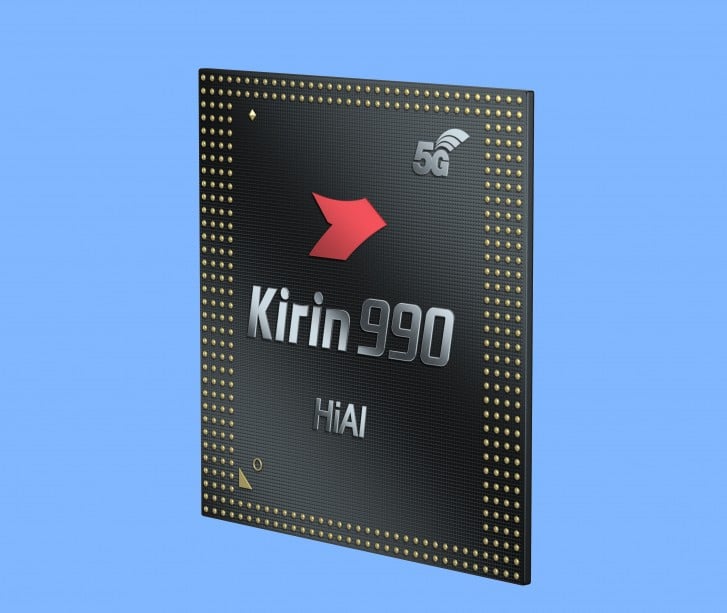Like every year, Huawei announced its new flagship mobile platform, the Kirin 990 at IFA 2019. The new Kirin 990 will power the Huawei Mate 30 series which is going to go official on September 19 and will hit the shelves in October.
Will the new Huawei’s SoC surprise everyone with its high performance and efficiency or will it will lag behind Qualcomm, Samsung and Apple chipsets that will power the upcoming flagships?
The public opinion is already divided, but before building an opinion it is better to gather all the information. And there are a lot of factors influencing it. Here, you will find 10 important things to know about the new HiSilicon Kirin 990, many of which may end up surprising you.

1Kirin 990 has an integrated 5G modem
Just like the newly-announced Exynos 980, the Kirin 990 is a chipset which integrates a 5G modem. And it will be the world’s first flagship chipset with an integrated 5G modem to hit the market. Until now, we have seen mobile processors with an external 5G modem in the shelves. To be accurate, Kirin 990 will come in two variants: one with 5G support which will include a Balong 5000 modem, and one LTE-only model. The 5G variant supports sub-6 GHz 5G networks on SA and NSA architectures and it will obviously be included in the most expensive versions of the upcoming Huawei’s flagships. The LTE-only variant should end up in less expensive flagships from the brand.
2Kirin 990 is built with the best production process
Huawei’s Kirin 990 mobile platform is built at 7 nm+ with the most advanced production process out there: TSMC’s 7FF+ with EUV. Note that only the 5G version of the chip is built with this production process, while the 4G variant is built at 7 nm just like the old Kirin 980. An advanced production process allows chipsets to be compact, efficient and powerful. And that is exactly the case of the Kirin 990.
Thanks to this advanced manufacturing process, Kirin 990 5G is the world’s first chipset with more than 10.3 billion transistors, while the 4G version has about 8 billion transistors which is still a huge amount.
3Kirin 990 should be better than Qualcomm Snapdragon 855
According to both Huawei and the first benchmarks, Kirin 990 will be slightly better than Qualcomm’s flagship option of this year: the Snapdragon 855. During the launch event at IFA 2019, Huawei showed the Geekbench results of both the chipsets and highlighted that Kirin 990 has 10 percent better single-core performance than Snapdragon 855 and 9 percent better multi-core performance. Huawei also claims that it has a 12 percent better big-core efficiency, 35 percent better middle-core efficiency, and 15 percent better little-core efficiency. Note that these terms indicate the three clusters which the Kirin 990 includes.
The 5G variant of the chipset has an octa-core architecture composed of 2x Cortex-A76 CPUs running at 2.86 GHz (big-cores), 2x Cortex-A76 (middle) clocked at 2.36 GHz and 4x Cortex-A55 (little) running at 1.95 GHz. The clock frequency of the middle and little cores is slightly lower for the 4G version of the SoC (2.09 and 1.86 GHz respectively).
4World’s first chipset with ISP 5.0 (BM3D) for DSLR-quality noise reduction
If there is one feature which has been Huawei’s focus in the past few years, that’s photography. The Kirin 990 is able to provide DSLR-quality image noise reduction through a new filtering algorithm called BM3D (Block Match 3D) which significantly improves its noise reduction capability in images.
5Support for 8K video recording
Kirin 990 even supports 8K video recording at 30 fps with HDR. And it is able to improve noise reduction even in videos. The Kirin 990’s NPU is able to cooperate with the ISP in order to provide a better image quality on all levels, with tons of revolutionary features and technologies. That is why you will see a lot of improvements in photography and videography.
6Same GPU as 980 but better graphics performance
Kirin 990 includes a Mali G76 MP16 GPU clocked at 700 MHz: it is the same GPU as the Kirin 980, yet it provides better performance because it integrates 16 cores: 6 more cores compared to the 10 cores found on the Kirin 980. Both the 4G and the 5G version will have this architecture for the GPU. While the Mali G76 has a slightly lower frequency, Huawei believes a wider GPU will improve the chipset performance even if the frequency and the voltage are lower.
⇒ Read More: Huawei’s Global Product Manager says HarmonyOS is coming to watches, laptops
7A separate Kirin A1 co-processor for less intensive tasks
In order to improve the Kirin 990, Huawei has adopted a co-processor called Kirin A1 for Bluetooth, audio decoding and applications which do not require a lot of power. Thanks to this additional unit, the load on the chipset is reduced and the overall performance is indirectly improved.
8Quad-core NPU for AI with DaVinci architecture
If we compare the Kirin 990 with its predecessor, the biggest difference we’ll notice is the NPU (Neural Processing Unit). An element which is often ignored by the average user, but is very important in everyday application. Huawei has used the new DaVinci architecture for the NPU of the Kirin 990, which was first seen on Kirin 810 launched earlier this year. The ‘Big’ Da Vinci cores support both INT8 and FP16 quantization of networks which offers better power solutions to ML inference problems. Further, Huawei has added a Tiny Core NPU that is a smaller and very power-efficient version of Da Vinci architecture connected over the AXI bus. It has lower performance but it can process a lot of tasks to save energy.
9Kirin 990 is coming soon on Huawei Mate 30
As we said earlier in this article, Kirin 990 will be the world’s first chipset with an integrated 5G modem to hit the market. Indeed, it will debut in less than two weeks on the Huawei Mate 30 series. The new flagship line-up will be officially unveiled on September 19 and it will start hitting the shelves in October.
⇒ Read More: Huawei unveils Freebuds 3 with a new design and a Kirin A1 chip
10There will be more affordable Honor smartphones with the chipset
If you are a Huawei fan you know that the company usually releases more affordable devices with its flagship chipsets, after its most important flagship phones. Usually, the first affordable high-end devices to come with Huawei’s flagship chipsets are released by its sub-brand Honor.
We know for sure that Honor’s first 5G flagship, the Honor V30 5G will feature this Kirin 990 5G. We won’t be surprised to see more smartphones with this chipset in the coming months.







